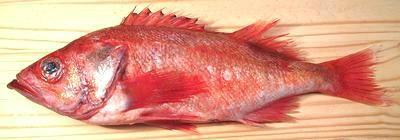 [Longjaw Rockfish, Pacific Ocean Perch; Sebastes alutus]
[Longjaw Rockfish, Pacific Ocean Perch; Sebastes alutus]
This Pacific rockfish, easily recognized by the nubby protrusion on it's lower lip (no, it isn't a cold sore) is found from the northern tip of Japan all the way around and down to San Diego, California but is most opulous along the south coast and islands of Alaska and around the Kamchatka Peninsula. This fish can live for about 100 years and can grow to 21 inches and 4.6 pounds, but the photo specimen was 16-1/4 inches and weighed 1 pounds 15 ounces.
This fish can occasionally be found in Asian fish markets in Southern California. As with all rockfish it is wild caught and this fish is currently considered severely overfished. IUCN Red List NE (Not Evaluated)
More on Rockfish.
Pacific Ocean Perch is an excellent eating fish (when fresh) with near white, moderately flavored flesh that is tender but holds together well with any cooking method. It separates into large flakes and it's easy to eliminate all bones.
Cleaning: No particular problems cleaning this fish. The scales are fairly large and easy to scrape off without a lot of flying around. There are a few that stick hard on the lateral line and would need to be pulled off with long nose pliers only if you intend to leave the skin on.
Use your filleting knife, sharp edge out, to cut from the vent to the fins, then your kitchen shears to cut from the fins up to the chin. You will have to use your kitchen shears to cut the esophagus and the bottom end of the gill arches.
Fillet: Ocean Perch is rather easy to fillet, with easy to follow fin rays and bones.
Skin: The skin is strong, thick and gelatinous, but doesn't have a strong or unpleasant taste. Unfortunately it shrinks very severely when heated and it'll curl your fillets into a tight roll. Fortunately it's a very easy fish to skin using the long knife and cutting board method. Keep the knife edge tilted a little more toward the skin than with a fish with a more tender skin.
Yield: A 1 pound 15 ounce fish yielded fillets weighing 15-1/8 ounces skin-on fillet (49%), 13 ounces skin-off (42%), which is very good for a large head fish like this. A smaller fish will yield a bit less, a larger fish a bit more.
Stock: The head, bones and fins make a moderate flavored stock suitable for soup. The skins would probably also be usable as they don't have a strong taste. Use plenty of water and bring it to a boil in an open pot. As it nears boiling use a skimmer to remove the heavy foam. Once it's boiling set it to a low simmer for 1/2 hour.
sf_rockrez 100411 - www.clovegarden.com